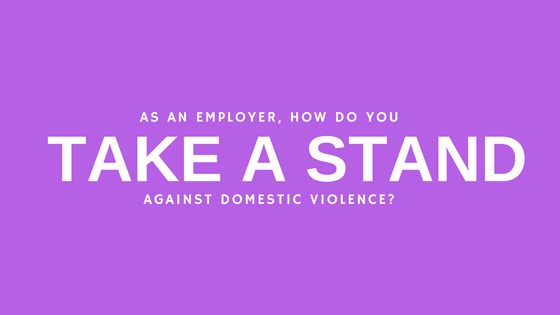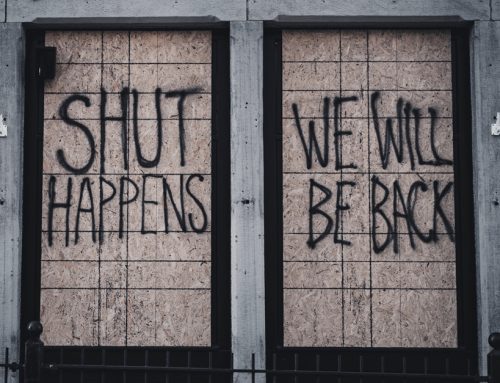By John Salter and Vanessa Hernandez
Domestic Violence Awareness Month may be over, but the drive to improve responses to it in the workplace are just beginning.
This week, a full bench of the Australian Work Commission is sitting in Melbourne to hear and determine a test case claim by the Australian Council of Trade Unions (ACTU), which is seeking to install a legal entitlement in all industrial awards for 10 days paid domestic violence leave to be provided as a global national entitlement.
This follows on from today’s announcement from male-domianted employer Lend Lease that they have agreed to new wage deals that include 10 days paid domestic violence leave in five states, and the recent announcement by Qantas that it will provide 10 days domestic and family violence leave to all its 30,000 employees by the end of the year.
It is clear that moves are afoot amongst Australian employers to take a stronger stance in supporting employees who are suffering from domestic violence outside of the workplace.
The statistics tell us why. In Australia, one in four women experience violence at the hands of a current or former partner. With a number like this, it’s almost certain that if you employ women in your workplace, you will have staff who have been or are being impacted by domestic violence. But knowing about it and knowing what to do about it as an employer can be tough, especially for those businesses who might not be in a position to accommodate the cost and interruption of formal domestic violence leave. So, as an employer, what can and should you do?
Firstly, what exactly is considered domestic violence?
Domestic violence takes many different forms but generically, it is a pattern of abusive behaviour through which a person seeks to control and dominate another person. What is clear is that it is no longer just physical violence, but can include, amongst other things, emotional abuse, economic abuse, psychological abuse, threatening or coercive behaviour, damage to property and unauthorised surveillance.
For more information on what domestic violence is, click here.
Is it a workplace issue, and is it any of my business?
Within the population of women who have experienced violence, or are currently experiencing violence, the Australian Bureau of Statistics estimates that between 55% and 70% are currently in the workforce – that is, approximately 800,000 women, or around one in six female workers. This means that a significant number of Australian workplaces will be impacted by women’s experiences of domestic and family violence.
The 2011 National Domestic Violence and Workplace Survey found that:-
- 81% of those who took the Survey were women. Of those, two-thirds were in full-time employment and a third had personally experience domestic violence.
- Nearly half of those who experienced domestic violence reported that the violence affected their capacity to get to work with respondents to the survey listing “physical injury or restraint” (67%) or hiding keys and failure to care for children as the major reasons.
- 19% of those who experience domestic violence in the previous 12 months reported that the violence continued in the workplace via abusive phone calls and emails (12%) and on other occasions, by the partner physically attending the workplace (11%).
- Respondents to the survey reported feeling distracted, tired or unwell at work (16%) with 10% needing to take time off work and 7% being late for work.
- 45% of those with recent experience of domestic violence discussed the violence with someone at work e.g. co-workers or friends.
- 48% disclosed the violence to a manager/supervisor, but only 10% found that helpful.
- For those who did not discuss the issue at work, the major reasons given were ‘privacy’ and reasons of shame or fear of dismissal.
- All respondents thought that domestic violence could impact the work lives of employees (100%) and 78% believed that workplace entitlements could reduce the impact of domestic violence in the workplace.
There is no doubt from these statistics that domestic violence is a workplace issue, and as an employer you need to make it your business to understand it, support employees through it, and prevent it from entering or otherwise impacting the workplace.
How will I know about it?
The short answer is, you won’t always know about it. Domestic violence is not just physical and classic signs such as facial bruising will not always be obvious or even exist. Emotionally and psychologically abusive relationships can destroy self-worth, cause anxiety and depression – symptoms which are much harder to identify in a workplace setting.
As an employer, the ‘symptoms’ you might notice may include:
- an increase in absenteeism.
- a decrease in productivity or quality of work.
- increased anxiety.
- changes in mood.
You won’t always be able to identify that symptoms like these are as a direct result of domestic violence, but you will notice that something is negatively affecting your employee.
As an employer, it’s important to understand that the workplace may be perceived as a ‘safe haven’ for your employee- perhaps the only one they have!!, . The income you provide may be their only form of financial independence or survival against an abusive and financially controlling partner. Their reluctance to disclose the truth about their home life may be as a result of their fear that they will lose that safe haven.
Other times, the signs might be more obvious. Your employee may attend work with bruising or injuries, or in some cases may approach you to ask for time off to attend Court. Other times, another employee may raise the concern with you or an abusive partner may call the workplace or attend in person.
What would you do in this scenario?
Let’s say you have an employee named Jane who is experiencing domestic violence. One day, Jane calls in sick and admits to you on the phone that she has suffered visible injuries as a result of domestic violence and cannot come into work. Jane expresses to you that she is fearful of her partner and does not know what to do. You encourage Jane to stay home and get some assistance.
Unknown to you, Jane then contacts her friend Tracey who is also your employee, telling her the situation. She keeps communicating with Tracey throughout the day and tells Tracey that she is fearful for her safety when her partner returns as he has threatened more violence. When the partner returns home, Tracey no longer hears from Jane despite numerous attempts to call her to make sure she is ok. Also unknown to you, Tracey has also experienced domestic violence in a previous relationship.
Tracey comes into your office and explains that she is fearful for Jane, and that she thinks she needs to call the police. She is upset and anxious. What do you do? Do you call 000? Do you call a local police station or Police Link? Do you do nothing and hope to hear from Jane soon?
Jane comes into work the next day and is visibly injured and is not herself. Do you let her work the day? Do you send her home? What information do you provide her? Can you assist her with getting in touch with the right services? Do you know what services are available and local to you? Do you classify her absence as sick leave or personal leave?
Jane’s partner arrives at the workplace demanding to see his wife and abusing your staff. He sees Tracey, knowing she is Jane’s friend and abuses her in a threatening manner, demanding to see Jane. Do you have any policies or safety planning in place for this? Do your staff know what to do? What happens if someone was injured? Are you responsible?
Tracey tells you she needs to take the day off, she is too distraught and tells you that the incident has caused her to re-live her previous trauma. Do you allow her to take the day off? What policies do you have in place to de-brief with Tracey and the other staff involved? Do you know what services are available to assist Tracey? Where do you even begin to plan for such a situation?
If you don’t know the answer to many of these questions, it’s probably time to do some thoughtful and careful planning.
What should I do first?
Workplaces can play an important role in providing safe and supportive environments for people who are experiencing domestic violence. But as well as providing a potential safe haven, there are a range of actions employers can take to provide support for victims and survivors of domestic or family violence.
Not only will these benefit your employees, but there are also a number of business benefits that might arise including higher retention rates, higher staff morale, and higher health outcomes for all employees. But you need to make sure that you get it right from the start.
Inform and Educate
A critical first step is to inform and educate yourself about the many forms of domestic violence. Understand that abuse does not discriminate. It happens at all ages, in both heterosexual and same-sex relationships, to all ethnicities and at all economic levels. Understand that even witnessing an act of violence or abusive behaviour can trigger trauma to a survivor of domestic violence. Once you have educated yourself, implement training and policies throughout the workplace and ensure that information is readily available to staff.
A good place to start is the Domestic Violence Policies and Procedures guide from the Australian Human Rights Commission web site which you can find here. Get in touch with a local domestic violence service and other such organisations, and partner with them to assist with training and support. Use the Information and Referrals guide from the Human Rights Commission web site which you can access here. Develop and Implement safety planning procedures. Some ideas on how to get that started can be found here.
Get Involved
There is a strong public awareness campaign emerging to combat this issue and employers are being urged to actively participate. Many employer lobby groups and industry associations are supporting the campaign and there are some (like the National Retailer’s Association) who are actually supporting the ACTU in its bid to create the national standard of 10 days paid domestic violence leave per annum.
Get Started
While not all employers will be in a position to provide paid domestic and family leave, there are things we can all do to take a stronger stance in supporting employees who are suffering from domestic violence outside or within the workplace.
Simply put, domestic violence is not okay. It’s not okay in the privacy of our homes, and it’s not okay in our workplaces and given the current momentum, any employer who sits still and does nothing may suffer future reputational damage by doing so.






